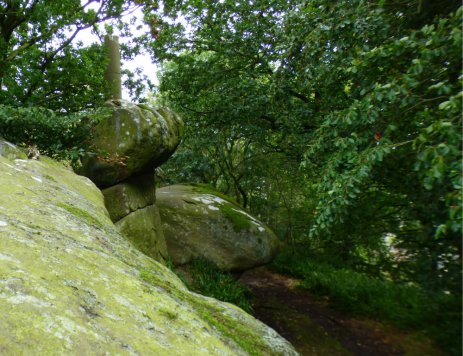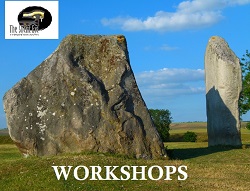
We walked straight past the entrance, a tiny wooded track that looked as if it had been made by local children playing in the woods. Which is probably why we ended up forging through the undergrowth on a most precarious slope, wondering whether or not this was going to be worth it.

We knew little about the place, except that it had once been associated with the druids… but only, apparently, in local memory due to a Friendly Society, known as the Ancient Order of Druids, who used to meet at the Inn back in the 1700s.

The Victorians, though, never missing the proverbial trick, had marketed the place as a druidic relic for tourists, adding romance to what might be little more than a glorified garden feature for all we knew.

The ‘castle’ is no such thing… it is a large, natural outcrop of rock, forming what looks rather like a castle on a hill behind the pub. Or it would, were it not now invaded by trees. We weren’t overly hopeful, you might gather, except for a couple of things that made the site intriguing.

It stands within the extended sacred landscape around Stanton Moor. There are a number of ancient sites… several stone circles and a Bronze Age necropolis… and those were just the major sites we knew of offhand.

There are also some exceedingly unusual prehistoric rock carvings… though, not knowing precisely where to look amongst the towering rocks, we were unlikely to find the best of them on this un-researched visit.

And then, there was the ‘other stuff’ that you couldn’t possibly miss… like the caves and tunnels, the pitch-black cells, the staircases dropping down through the earth and the column erected on the highest rock.

The place is, almost inevitably, said to be haunted. A hooded figure is often seen, particularly by the steps leading from the ‘condemned man’s cell’ to the ‘sacrificial platform’ above. The Victorians have a lot to answer for…

Be that as it may, Thomas Eyre, a minister of the Church and a member of the family after whom Charlotte Bronte named her famous heroine, must have been up to something when he carved these caverns, staircases and chambers from the rocks three hundred years ago.

There are a number of rocking stones too, including one that weighs around fifty tons, yet could be moved by a single hand…until Whit Sunday in 1799 when a group of local lads dislodged it completely. The stone was put back in place, but the magical balance was lost.

It is an intriguing place and one that deserves to be properly explored. Next time, the research will hopefully lead us to the rock carvings. There is a lot going on here…too much for a single visit… and we had plenty of food for thought as we descended by the little track we had originally missed. Just what was Thomas Eyre doing up there? We could hazard a guess…




Wow! Such an amazing place. I wonder what its real story is, Victorians apart.
LikeLike
Stuart, am I right in thinking you and Sue took Ess and I here? It certainly looks familiar
LikeLiked by 1 person
Yes, that’s correct, Graeme… There is a lot more to it than seen here. It’s just above the Druid Inn where we had lunch… Happy Days… 😉
LikeLiked by 1 person
I seem to think we were there for a while – plenty to see and talk about. We really were privileged to have those experiences with you both.
LikeLiked by 1 person
The full story of this place, and Bakewell Church, which I don’t think we got to with you and Ess, eventually made it into one of the books… 😉
LikeLiked by 1 person
A useful reminder that I need to read more of them. No, we didn’t go to Bakewell church. After lunch, we headed into a field with some standing stones, though I seem to recall some initial uncertainty about how to get to them
LikeLiked by 1 person
I think that would have been nine stone close, though there’s now only four of them… 😉
LikeLiked by 1 person